Steve Sheldon and members of the Sheldon Family were prominent figures in Haines and instrumental in the establishment of the Sheldon Museum and Cultural Center. Steve and his wife Elisabeth “Bess” Berkinbine Sheldon were avid collectors and their collection forms the nucleus of the Sheldon Museum’s current collection. Their daughters Elisabeth “Lib” Hakkinen and Harriet Brakken donated their parents’ collection to the community and Lib pioneered building the facility you see today.
Steve Sheldon and Elisabeth “Bess” Birkinbine Sheldon
Elisabeth “Lib” Sheldon Hakkinen and Whitey “Felix” Hakkinen
Steve Sheldon and Elisabeth “Bess” Berkinbine Sheldon
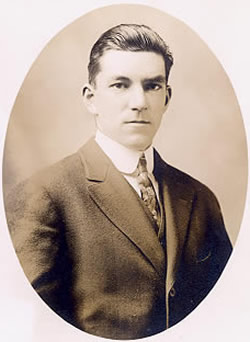
Steve Sheldon in his early 20s.
Stephen Sheldon was born in Columbus, Ohio May 27, 1885. His father, Frederick Beaumont Sheldon, was born and educated in England, where he was the youngest student to pass the entrance exams for Oxford. After finishing school he and his brother immigrated to the United States. At the time of his death in 1927 he had been Vice president of the New York Central Railway for several years. Steve’s mother, Harriet Ellen Thrall, was born in Iowa and was a descendant of Peter Brown, who arrived on this country on the Mayflower.
When Steve was 16 years old he went to England where he attended school at Sandbach for two years. While there, he received a gold medal for school’s outstanding athlete, presented by Florence Nightingale. On his return he entered Ohio State University’s school of engineering for two years. The summer between those years he worked on the Orpheum Circuit doing song -and -dance routines and learning prestidigitation (the art of magic and sleight of hand). These skills he maintained all his life, using them frequently in local vaudeville, minstrel and variety shows, along with his ability to coax a tune from almost any instrument.
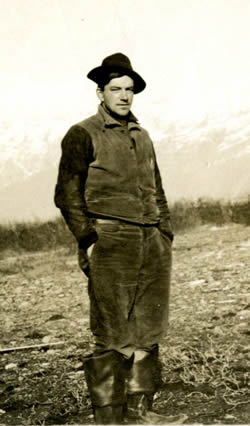
Steve Sheldon on the Alaska Midland Rail Road Survey, 1912.
After leaving Ohio State, he and George Jones, a life-long friend, started west looking for work, as the “panic” of the early 20th century was going on. They worked in hay fields in Oklahoma, and orange groves in California, eventually finding their way to Seattle. Steve managed to get a job as a storekeeper on the Alaska Steamship “Northwestern” and made seven trips to Nome. During one of his trips, the ship was held fast in the ice in the Bering Sea for a time. Intrigued with Alaska, he applied for work with Michael J. Heney who was building the Copper River and Northwestern Railroad out of Cordova. The winter between his two seasons there, he was a storekeeper in a remote supply station far up the track. When that railroad was completed, some of the crew members went with their boss, John Rosene, to Haines to work on the survey for the Alaska Midland Railroad which was to connect Fairbanks with the deep-water port of Haines. When he arrived in 1911, he worked with another young engineer, H. P. M. Birkinbine or “Birk”. When Birk found that he would be detained up-river, he asked Steve to meet the ship when his sister came to visit for a month or so.
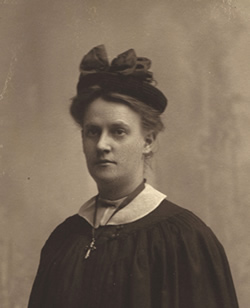
Elisabeth “Bess” Berkinebine in her nurse’s cape.
Elisabeth Neidly Birkinbine or “Bess” was born in Philadelphia September 22, 1885. Her father, also an engineer, specialized in waterworks, completing a water system for Philadelphia, then building one for Council Bluffs, Iowa, only to return to Philadelphia to enlarge their system. Bess’s mother, Louise Chadwick, was the daughter of a Boston sea captain. Bess went briefly to Vassar, decided she wanted to be a nurse so she transferred to Jefferson Medical School of Nursing, and then worked out of a “Settlement house” in the slums of Philadelphia. Her father and older sister were killed in the first traffic accident in Philadelphia involving an automobile. They were riding in their horse-drawn buggy when they were struck by a car. Both were killed instantly. Mrs. Birkinbine saw the accident, had a heart attack and died within ten days. Bess had already begun packing to move to Chicago to work at Hull House. Devastated by the loss of her family, she packed a few favorite family items and went to visit her brother “Birk” in Haines, Alaska, arriving in May of 1912. She planned to return in the early fall.
When the teacher for the Bureau of Indian Affairs School was taken ill and unable to come to Haines, Bess was hired to teach the winter of 1912-13. Half the teacher’s job at the BIA School was public health work in the village, and a nurse was as good at teaching as a teacher was at nursing. This was work Bess could handle.
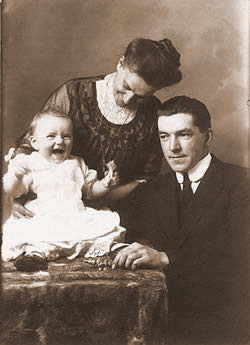
Bess, Steve and baby Lib, 1914.
Steve Sheldon had taken a job with J.W. Martin for the winter, building Ashley stoves. Bess Birkinbine and Steve Sheldon were married March 23, 1913. The young people had both been raised in homes with plenty of household help, so were not well prepared for life in the 2-room cabin on the northwest corner of Union Street and 2nd Avenue which they called home. There was wood heat, of course, and no plumbing of any sort, but there was a well about half a block away. This was the little house where they brought home their first child, Elisabeth Anne or “Lib,” who had been born in Skagway’s White Pass Hospital on January 11, 1914, because the Haines doctor was away on vacation.
When Martin’s store was sold to N.G. Hansen, Steve built stoves for the new owner and the little family lived in a somewhat larger house behind the hardware store. Stephen Jr., born February 4, 1916 was brought home to this house from the Presbyterian Hospital across the street. The Sheldons then bought Hansen’s stove business and move into George Vogel’s building just down the street, taking over the Post Office from Vogel, and adding a prescription counter at the urging and help of the doctors stationed at Ford Seward. A soda fountain was soon added to their sales effort. The third Sheldon child arrived in that building August 19, 1918, and was named Harriet Louise for her two grandmothers. The family lived upstairs over the stove shop/drug store/Post Office. They added the service of a small telephone system which connected the Army’s Fort Seward phones, the U.S. Commissioner, Bob Ferry’s and Tim Vogel’s Saloons and the Deputy U.S. Marshall’s home.
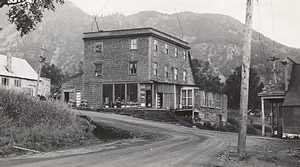
The Sheldon Hotel, formerly Jack Dalton’s Hotel on the corner of Main and Front Street, 1943.
Charlie Hockett had been running Jack Dalton’s Hotel on the corner of Main and Front Street. When he left town in the fall of 1919, the Sheldons bought the hotel from him. The family lived on the third floor. They had seven rooms for rent on the second floor and the street floor housed the trading-post items they had taken over from Hockett, plus the drug store and soda fountain. The Sheldon’s fourth child, Frederick Beaumont, was born there January 19, 1921. The following year they bought the Elite Steam Laundry from Homer O. Banta, and operated it for several years as well.
About the time that Prohibition was passed, Steve was appointed Deputy U.S. Marshall, covering Haines and Skagway. To save funds, the Federal Government decided he should also cover Yakutat once a week. To the people in Washington D.C. it looked pretty close on the map. Steve made one trip over to Yakutat, but the trip entailed catching a steamer south to Juneau, waiting for the ship to return south from Cordova, Valdez and Seward in order to get back to Juneau where he waited for the next northbound ship to Haines. The round trip took nearly two weeks. It was decided that one of the Juneau deputies could handle Yakutat more economically.
In the 1930s the Sheldons added more groceries to the store stock but still relied heavily on the tourists the Alaska Steamship Company and Admiral Line ships brought to the city dock at the foot of Main Street. In 1925 they had begun showing their collection of artifacts, displayed on top shelves of the store and in the living room they had added on the bay side of the main floor of the building. Both of the Sheldons were collectors, Steve having started at the age of 8. Bess had collected a few choice china items in Pennsylvania, but the bulk of her treasures were beadwork and baskets made in Haines and Klukwan.
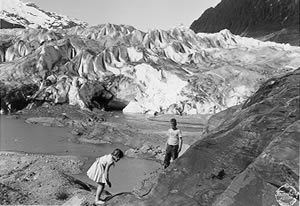
The Sheldon kids on a family outing to Davidson Glacier.
The busy, happy family was outdoors orientated during all seasons: hiking, camping, picnicking, skating, skiing and coasting. They were especially active in sports, music and the variety shows which Haines specialized in during the winters.
In the mid-twenties Steve bought his first boat, the “Alaska,” a former fishing boat, which they used for picnics, camping and exploring Lynn Canal. Later they owned the “Annie B”, then the “Sea Parrot” –the Army’s 64’11″ “J-44” with a cantankerous Diesel engine. It was the first one licensed to carry paying passengers on charter, with his daughter Harriet (home from college for the summer) as crew. During World War II, it was requisitioned by the Army for “casual” use, whatever that means! Much as Steve enjoyed his boats, they never became a source of much revenue, so he sold the last one in the forties.
During the building of the Haines Cutoff Road in 1943, Steve worked as a warehouseman for the construction company hired to upgrade the road after the Army finished the basic haul-road.
When Bess died in January 1950, their oldest daughter Elisabeth and her husband, Felix “Whitey” Hakkinen bought out the family store business and part of the land. They built a new store with an apartment for their family upstairs. Steve began spending part of his summers with them, showing his collection to tourists. He made his home base in Seattle with his daughter Harriet and her husband, Harold Brakken. Christmas holidays he spent with his brother and sisters wherever they gathered in Ohio, Texas or Florida. He drove around the country, usually alone, frequently stopping in Elks Clubs everywhere, and visited Mexico, Cuba and Hawaii.
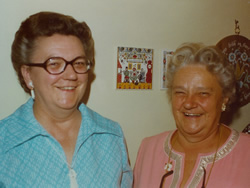
Harriet Sheldon Brakken & Lib Hakkinen, mid 1970s. Lib passed away on October 5th, 2005 and Harriet passed away on March 22, 2012. None of the Sheldon family descendants currently live in Haines.
Steve died of cancer in Seattle during August of 1960, almost 3 months before he could have cast his first-ever vote for President of the United States because of Alaska becoming a State.
The Sheldon daughters inherited the already well-known Sheldon Collection and donated it to form the nucleus of the Sheldon Museum and Cultural Center you visit today.
Elisabeth “Lib” Hakkinen, 1990s
Elisabeth “Lib” Sheldon Hakkinen
and Whitey “Felix” Hakkinen
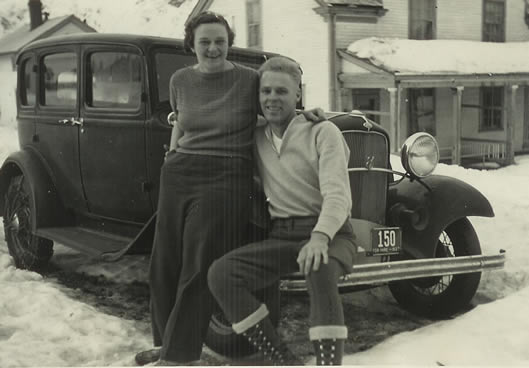
Lib and Whitey Hakkinen, 1937
Although best known for being instrumental in establishing the Sheldon Museum and Cultural Center, both Elisabeth “Lib” and Felix “Whitey” Hakkinen’s lives were rich with adventure and diverse activities.
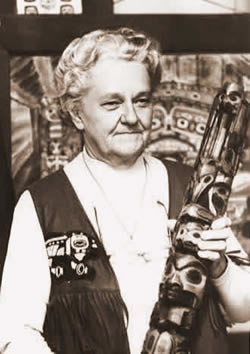
Lib holding the Friendship Pole, 1978.
Lib was born in Skagway, Alaska on January 11th, 1914, to Steve Sheldon and Elisabeth “Beth” Birkinbine Sheldon of Haines. She graduated from Haines High School and attended college in California and Ohio, where she earned an Associate Degree, then returned to the town she loved, to teach school. It was during this period that she met her future husband, Felix “Whitey” Hakkinen, who was stationed at Fort Seward.
Whitey was born in Ashtabula, Ohio in 1910, to Finnish immigrants Fredrick and Sofia Hakkinen. The family moved to Southern California in 1920, where Whitey graduated from high school in 1925. After 15 months in the Civilian Conservation Corps in California and a year in Vermont and other travels, he joined the army on the promise he would be stationed in Alaska.
Lib and Whitey were married in July of 1940.
Just before the beginning of WW II, the Hakkinens were transferred to Sitka and their first child, Fred, was born there. A couple of years later a second child, Betsy, was born in Vanport, Oregon where Whitey was employed as a welder at the Kaiser shipyard.
The Hakkinens moved back to Haines after the war. Whitey worked as a pipeline welder in the Yukon Territory and Lib took a job as a teacher. On the death of Lib’s mother in 1950, the couple bought Steve Sheldon’s grocery store, enlarged and improved it and operated it as “The Market Basket” for the next 22 years.
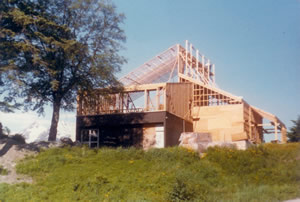
The Sheldon Museum and Cultural Center under construction in 1978. This view is from the Lighthouse Restaurant parking lot looking west, up the hill toward Main Street.
Whitey worked full time in the store, as did Lib after teaching for a couple of years. She spent most of her spare time doing volunteer Girl Scout work, writing historical sketches, and taking courses in “Museology” so the couple could fulfill their promise to Lib’s father that they would try to turn the “Sheldon Collection” into the “Sheldon Museum.”
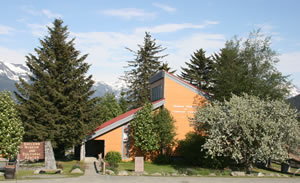
The Sheldon Museum & Cultural Center from the Museum’s parking looking east down the hill toward the Lynn Canal, 2011.
With the help of the Haines Women’s Club, the Chilkat Valley Historical Society, several grants and various other civic-minded organizations, Steve Sheldon’s dream of a museum in Haines became a functioning reality in 1980. In 1991 it was accredited by the American Association of Museums.
Both Whitey and Lib were adventurous and avid lovers of the outdoors. They loved to hike, explore nature and travel. Their travels covered much of the U.S., Canada, and parts of Europe “filling their memory banks to draw from when they could no longer travel.”
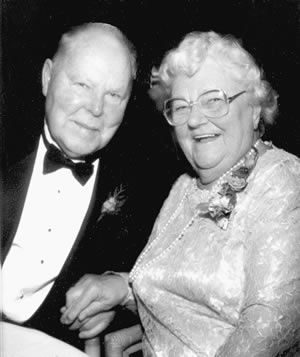
Lib and Whitey Hakkinen, 2000.
In the fall of 1995, the Hakkinens decided the time had come to retire and move closer to family and better medical care—especially since their son, a physician in Portland, said it was becoming increasingly difficult to diagnose their health problems by telephone! They resettled in King City, Oregon near their daughter, Betsy.
After 60 years of marriage Whitey passed away on December 7th, 2000. Lib followed her husband in death on October 2nd, 2005.
Blythe Carter, 2009
Bibliography:
Elisabeth S. Sheldon, Haines the First Century 2009 Edition.
